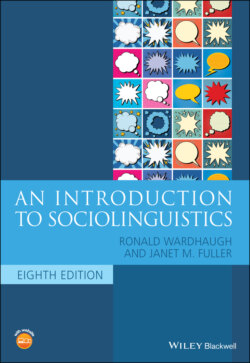Читать книгу An Introduction to Sociolinguistics - Ronald Wardhaugh, Janet M. Fuller - Страница 86
Exercises
Оглавление1 Make a short (15–30 minutes) audio recording of a community of practice you participate in (be sure you have the permission of everyone in the group before you record!). This could be your roommates or family members you live with, some friends you often eat lunch with, a group of co‐workers, members of a knitting group, your rugby teammates, and so on; the only criteria is that this must be a group that meets and interacts regularly. Listen to the recording and answer the following questions:How can you describe the joint endeavor of this group? Do there seem to be common goals of the interaction?In what ways are the varieties spoken by the individuals in the group different – that is, do they come from different areas or social groups and have linguistic features that are associated with different varieties? Is there ever explicit mention made of speech differences?In what ways do you see the shared norms of the group – are there particular lexical items or nicknames that are used in this group? Inside jokes? Topics of conversation that recur? In short, try to ascertain what features of the conversation indicate that this is a group that interacts frequently and not a group of strangers.
2 Find a map of the country you live in which has major state or province boundaries but no labels for these regions, and ask ten people to draw dialect boundaries on the map, name the dialects, and rate them on scales of 1–10 in terms of correctness and pleasantness. Be sure to record relevant information about each of these research participants – for instance, age, sex category identification, nationality, race/ethnicity, socioeconomic class identification, occupation, location of residence, region of origin. Answer the following questions about your data:Are similar dialect regions identified by all or most of the research participants? Provide an overview of these regions.Are there accepted names for different dialects? If so, can you explain how this has come to be the case – are they discussed in popular media, or in school? If not, how can you explain the absence of terms for regional dialects?How are different regional dialects evaluated in terms of their correctness and pleasantness?How can you account for variation in your data? That is, do particular traits of the research participants (e.g., where they are from) seem to influence how they feel about particular dialects?
3 Find a YouTube video that is related to how a particular social group uses language – this may be intentionally about the language (e.g., a ‘tutorial’ or description of a particular dialect, a satire about how a certain group uses language) or a video in which users of a particular variety are talking about something else, but the comments and distribution of the video focus on the way they talk. What language ideologies are represented in this video? Do they represent ideologies that you, with your budding knowledge of sociolinguistics, would like to challenge?
